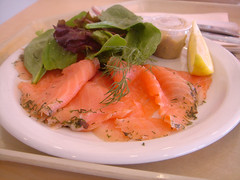Gravad Laks

(For the authentic recipe and spelling—in Danish—check here. Note: if the salmon isn’t very fresh, I’d always wash it quickly first!)
Nigella is always good for some stress-free Christmas cheer and her ‘gravlax’ recipe brings some fresh spin to this traditional Scandinavian delicacy. She replaces the traditionally used white pepper with made English mustard (similar to wasabi in its firey-ness) and spices up the fish with a dash of gin. Where we differ (aside from the spelling and the salmon steaks the BBC website uses as illustration, instead of fillets) is in the way the fish is arranged for the cure. The two fillets should always be placed skin-side out, with the thinner belly of one pressed against the thicker back fillet of the second. This ensures that even pressure can be applied during curing and it’s how it is done traditionally.
Aside from that, this is a very easy dish to make, but very expensive to buy. Serve the gravad laks on thin, buttered rye bread with an ice-cold aquavit on the side. With this particular cure, a simple sprinkling with lemon juice and cracked pepper works well, as would salsa verde. I tend to avoid the disgustingly sweet traditional sauce (searching for ‘gravad laks savs’ gives exactly one Google hit! —Luckily it was to a Danish recipe search engine.) If you want to try it, there are many variations of the traditional dressing, but all contain mustard and (usually dried) dill, along with lashings of sugar.
I’ve increased the amount of salt and sugar slightly, but it actually needs surprisingly little salt and sugar—certainly not enough to ‘cover’ the fish. The Danish recipes I looked at use roughly 50g of each per kg salmon, or occasionally 2:3 salt:sugar working out to a similar final amount.
2 large salmon fillets; 3 tablespoons Malden salt (flaky); 2 tablespoons sugar; 1 tablespoon English mustard (Colemans, freshly made); 1 tablespoon gin; 1 bunch dill; (fresh dill for garnish)
Run your fingers over the meat to check for any small bones and remove with forceps. Briefly run some water over the salmon and pat dry thoroughly. Mix the salt, sugar, mustard and gin and evenly spread over the meat. Chop the dill and arrange over the fillets. Arrange in a dish as described above (skin-side out, one thin end over the other’s thick end), wrap in cling film and place a weight on top.
Keep in fridge for 48h, turning once or twice a day.
The hardest bit is cutting it. Get a knife with as long a blade as possible and sharpen it carefully, then slice with the blade held almost horizontally to get slightly transparent slivers of salmon, following the natural texture of the fillet from its thickest point downward, on both sides. You should be left with only the skin (this takes a bit of practice!).
I tried this recipe last week without problems. Alas, I don’t think it freezes sucessfully.
Tags: Travel, Tag Index